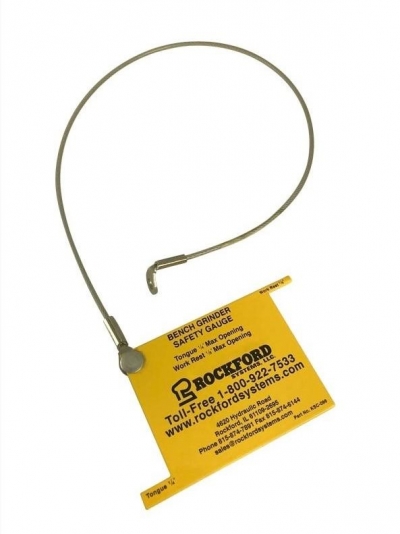
OSHA 29 CFR SubPart O 1910.215 for bench grinders is one of the most frequently cited machine-safety standards for violations during OSHA inspections, and one of the most dangerous to ignore. OSHA 1910.215 is a "machine specific" (vertical) regulation with a number of requirements, which if left unchecked, are often cited by OSHA as violations. ANSI B11.9-2010 (Grinders) and ANSI B7.1 2000 (Abrasive Wheels) also apply. The OSHA standard refers to safety measures that are required to prevent a workpiece from being jammed between a grinder's wheel and its rest, resulting in potential wheel breakage. Because grinders run at such high rotations per minute (RPM), wheels can actually explode when they break, potentially causing serious injuries, such as blindness, facial lacerations and even death.
A simple and effective solution is the Rockford Systems bench grinder safety gauge. It is for use during the installation, maintenance and inspection of bench/pedestal grinders to ensure compliance with OSHA 1910.215. OSHA specifies that work-rests must be kept adjusted to within 1/8-inch of the wheel to prevent the workpiece from being jammed between the wheel and the rest, resulting in potential wheel breakage. In addition, the distance between the grinding wheel and the adjustable tongue-guard (also known as a "spark arrestor") must never exceed 1/4-inch. Because the wheel wears down during use, both these dimensions must be regularly checked/adjusted.
"Grinder safety gauges" can be used during the installation, maintenance, and inspection of bench/pedestal grinders to make sure the work-rests and tongue-guards comply with OSHA's 1910.215 regulation and ANSI standards. Wait until the wheel has completely stopped and the grinder is properly "Locked Out" before using a grinder safety gauge. Grinder coast-down time takes several minutes, which tempts employees to use the grinder safety gauge while the wheel is still rotating. This practice is dangerous because it can cause wheel breakage.
Rockford Systems has added an 18-inch stainless steel tether to the grinder gauge, improving its ease of use and preventing it from being misplaced, lost or stolen. The tether can be securely attached to the machine stand so it is always next to the grinder. For greater visibility the gauge is safety yellow and features silk-screened text and graphics.
Contact Details
Related Glossary Terms
- grinding
grinding
Machining operation in which material is removed from the workpiece by a powered abrasive wheel, stone, belt, paste, sheet, compound, slurry, etc. Takes various forms: surface grinding (creates flat and/or squared surfaces); cylindrical grinding (for external cylindrical and tapered shapes, fillets, undercuts, etc.); centerless grinding; chamfering; thread and form grinding; tool and cutter grinding; offhand grinding; lapping and polishing (grinding with extremely fine grits to create ultrasmooth surfaces); honing; and disc grinding.
- grinding wheel
grinding wheel
Wheel formed from abrasive material mixed in a suitable matrix. Takes a variety of shapes but falls into two basic categories: one that cuts on its periphery, as in reciprocating grinding, and one that cuts on its side or face, as in tool and cutter grinding.






